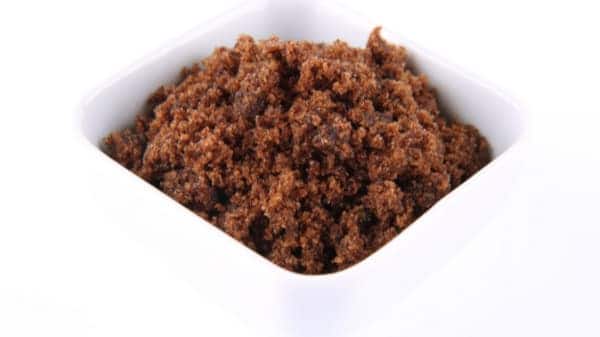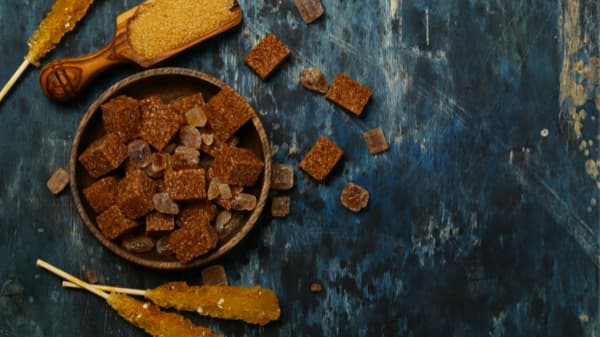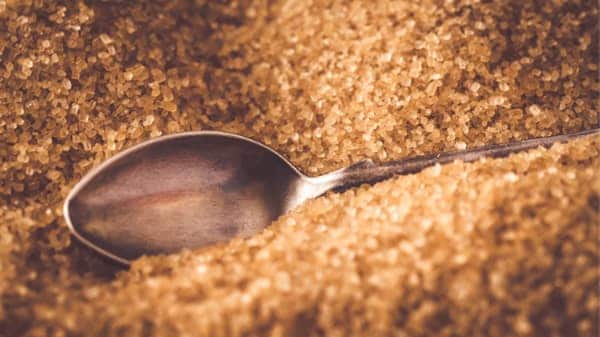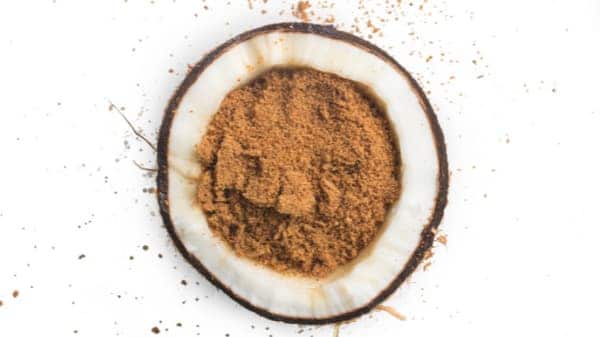Brown Sugar In Coffee: Is It Any Good?
Some coffee lovers will tell you that black is the purest way to drink coffee, but there are a lot of options for adding a little flavor and sweetness to your cup.
If you want to go for something a little less standard than the usual white, refined sugar, brown sugar in coffee is one of several appealing options. But does it work? And are there things you should keep in mind?
We have all the answers right here.

Which Is Better In Coffee: Brown or White Sugar?
The question of whether brown sugar or white sugar is better for coffee really comes down to taste.
Brown sugar has molasses in it, which adds an earthy flavor compared to white sugar, which has had everything but the sucrose refined out of it.
Brown also tends to taste sweeter than white sugar, due to the presence of other sugars, and you can use less of it.
Overall, brown is more complex in taste, which lends itself well to some of the different flavors in coffee.
It creates an entirely different taste experience, whether you choose light brown sugar or dark brown sugar to sweeten the brew.
Because it’s a product with more moisture, it also tends to dissolve more quickly. So this brings us to the next question.

Does Brown Sugar Taste Good In Coffee?
When it comes to brown sugar in coffee, there are a surprising number of variables.
Multiple types of brown sugar exist, which means that there’s one for every taste.
Coffee with brown sugar is no longer a question of light or dark brown sugar. Instead, you can sample the classic varieties as well as various newer kinds of unrefined sugar, such as raw sugar and piloncillo, and find the differences.
At the most basic, the majority of sugar in your local market comes from either sugar beet or sugar cane.
Cane sugar is the most popular form, made from refining molasses down into sucrose crystals. The refining process includes a bleaching step for white sugar, but the brown color of less refined sugars comes from residual molasses content.
The different varieties of brown sugar are processed slightly differently and often come from different parts of the world.
Types Of Sugar Compared
Piloncillo, for example, comes from Mexico, jaggery from India, where muscovado also comes from. Turbinado sugar is made in the US–typically in Florida and Hawaii–and demerara comes from Africa.
The different brown sugars you can find around the globe come with a few different properties, based on how they’re made.
Piloncillo and jaggery aren’t centrifuged and are usually cooked down in open pans over wood fires and poured into molds.
This process makes for a richer, more caramelized taste in the finished product that works very well with coffee.
The color of brown sugar is also different, depending on how it’s made. Light brown sugar has–obviously–a light brown color.
Dark brown sugar and most of the less-refined sugars are a darker color from natural molasses left in the process.

Standard brown sugar used to be simply less processed sugar cane juice with the molasses still left in.
Nowadays, however, most brown sugar (light or dark) is simply white sugar with some molasses added back.
Like turbinado and demerara, raw sugar is typically more processed than products like jaggery or piloncillo but less processed than what’s simply called brown sugar.
They’re usually coarser crystals and drier than brown sugar but not quite as dry as white sugar, though still with residual molasses.
So they’re a good introduction to the flavors that brown sugar in coffee can bring.
The primary reason people have their coffee with brown sugar is the taste, though some believe brown sugar to have health benefits compared to the white stuff.
Indeed, raw sugar, light brown sugar, and dark brown sugar (along with all the variations) have a higher mineral content than white sugar, which contains pure sugar crystals and nothing else. This is thanks to the molasses.
But multiple studies have shown that while many might believe brown sugar healthier than white table sugar, the amounts of minerals from the molasses in it just aren’t high enough to make a difference.
Overall, light brown sugar and raw sugar are less complex.
In contrast, darker brown sugar and those brown sugars that are minimally processed tend to have more complex caramel notes, resembling butterscotch.
What sweeteners work best will depend on your palate and the type of brew you’re sweetening.
Adding Brown Sugar To Coffee Grounds
While most people tend to add sugar to their cups of coffee rather than directly into the grounds before brewing, it’s definitely possible to sweeten your whole pot rather than by cup.
It does take some practice and testing to make sure you strike the right balance, but it can make for a smooth, sweet brew without extra effort in the morning.
The good news is that brown sugar actually works better than white sugar for this application!
This is because brown sugar dissolves in liquid more readily than white sugar, which allows it to blend into the brew as it passes through whatever filter type you’re using.
It works especially well in portafilters for manual espresso machines.
If you do use brown sugar in coffee grounds, make sure to clean your brewer more often.
That way, you can avoid the molasses-rich sugar crystals gumming up the works or encouraging spoilage and mold.
Brown Sugar For Certain Coffees
Given that the molasses content in brown sugar not only gives it a brown color but also minerals and other compounds that lend molasses flavor to the sweetener, you can see why it would suit some types of coffees more than others.
The best choices for using brown sugar for home coffee drinking are–a little obviously–those roasts and coffee blends that tend towards a more caramel, butterscotch, or creamy flavor.
The brown sugar will highlight the flavor profiles of those types of coffee with the richness of molasses in it, and you might find yourself enjoying the coffee even more.
If you want to try brown sugar at home in your coffee, we recommend that you try it first with darker roasts, particularly those from Latin America.
The molasses notes form a beautiful harmony with the sweet, caramel notes that dark Latin American coffees tend to have.
It’s also worth experimenting with different brewing methods because it’s definitely the case that brown sugar complements certain brews more than others.
For example, we prefer brown sugar to white sugar when it comes to brewing espresso, cafe Cubano, and some other rich, strong brewing methods.
Sugar Alternatives For Coffee
Of course, brown sugar isn’t the only option when it comes to alternative sweeteners for your coffee. If you’re looking to switch out the white sugar in your coffee for a different sweetener or even a lower-calorie choice, there are a lot of possibilities beyond brown sugar.
Honey
Honey is a classic sweetener for coffee, using honey to cut the bitterness of the brew predates even using sugar.
White sugar and brown sugar alike used to be far more expensive than they are today and reserved for medicine or the higher classes.
Honey imparts a gentle, floral sweetness to your coffee, and many people view it as a more natural choice than table sugar. It also dissolves more readily in cool or cold liquids.
Cinnamon

If you want to sweeten your coffee without adding any calories, you can bring cinnamon to the table.
Cinnamon’s spicy sweetness is a great counterpoint to the bitter, roasted flavors in any coffee, and you can incorporate it into your brew at any point from brewing to right before you take a sip.
Another benefit to using cinnamon in coffee is that a little goes a long way, so you can get your calorie-free sweet fix with added dimension and a reasonable price.
Stevia
One of the newer zero-calorie sweeteners on the market, Stevia is extracted from the leaves of a plant.
While many people swear that it’s impossible to tell the difference between stevia and sugar, more sensitive palates may find it a bit soapy in aftertaste.
Stevia is becoming more and more reasonable in price, making it a solid at-home choice for calorie-free sweetness in cooking and coffee alike.
Agave Nectar
Like honey, agave nectar is a syrup. Unlike honey, agave nectar is extracted from the core of a particular plant, the agave cactus.
It’s similar to maple syrup in terms of production, but it’s very different in flavor. Light agave syrup is relatively neutral in taste, and darker syrups have more caramel notes.
As with honey and other syrups, agave nectar has a similar calorie load to sugar, so if you’re looking for something lower in calories, it’s not necessarily your best bet.
Monk Fruit Extract
The newest zero-calorie sweetener on the market, monk fruit extract gets its sweetness from antioxidants rather than carbohydrates.
The slightly fruity taste complements a wide range of recipes but maybe somewhat off-putting if you’re looking for something more neutral.
If you want to experiment, we recommend monk fruit extract with more citrusy coffees, like dark roast Kenyan coffees and certain Latin American blends.
Coconut Sugar

Coconut sugar comes from the flowers of the coconut palm, and while it’s new in US, UK, and European supermarkets, it’s a very old sweetener in many parts of the world.
Available in many forms (liquid, block, and grains alike), it is a less refined sugar and has delightful caramel notes due to the darker nature of the sugar.
While no evidence exists to prove that it’s any healthier than white sugar, it can provide a tasty counterpoint to your morning brew.
While it has a brown sugar taste, it’s more complex than the usual molasses-added crystals you can get at the store.
Maple Syrup
Another classic method of sweetening, maple syrup comes from the sap of maple trees, usually harvested from February to April.
The flavor is familiar and pronounced: nobody would ever mistake maple syrup for light brown sugar or white sugar.
Just like honey, agave syrup, and brown sugar, maple syrup does have calories–and there’s little indication that it’s much better for you than table sugar.
But if you want something more interesting in your brew, it’s worth trying.
Wrapping Up
Is brown sugar healthier than white sugar?
The evidence suggests that sucrose is sucrose, and that while the molasses remaining in brown sugar gives it a deeper taste and more complex notes that can make it a more delicious sugar in coffee, it isn’t any more nutritious.
Brown sugar in coffee is definitely worth experimenting with!
Light brown sugar or raw sugar are good alternatives to white sugar if you want to bring something more complex to your drink, and the sugar crystals tend to dissolve more readily due to the molasses left in them.
Use brown sugar to give yourself a new kind of coffee experience and enjoy the novelty.

